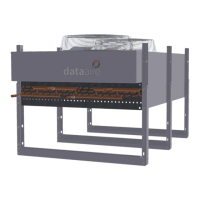21 • Air Cooled Condenser User Manual
WARNING: If a pressure washer is used, make sure the equipment is set to a lower
pressure setting and that the nozzle is set to the fan spray, not stream. Otherwise, dam-
age to the ns could result.
If a chemical cleaner is required, a non-acidic type cleaner is recommended.
WARNING: Acid-type cleaners can be aggressive to the coil ns as well as surrounding
areas. Many sites do not allow the use of acidic cleaners for environmental reasons.
6.3.3 How to Clean
The absolute best way to clean coils is from the inside out. This requires disconnecting the power
supply before working on the unit. The fan guards and fan blades must be removed to gain ac-
cess to the coil surface. The sprayer can then be worked across the coil using the water/cleaning
solution, pushing the dirt and debris out the bottom of the coil. Although this does extend the time
involved, the results are well worth it. This method should be used at least once a year. Spraying
the coil from the outside repeatedly can push a majority of the dirt to the inner section of the ns and
continue to restrict air flow.
Keep in mind you may not have the luxury of shutting the unit(s) down for an extended time. A pre-
scheduled shutdown with the operator may be in order.
WARNING: If you are using a chemical cleaner along with the spraying process, follow
recommended manufacturer instructions and be sure to rinse the coil thoroughly. Any
residue left on the coil can act as a magnet to dirt.
Reinstall and secure the fan blades and fan guards after the cleaning is nished. Last, reconnect
the power supply to the unit.
7.0 LINE SIZES
Please refer to evaporator Installation, Operation, & Maintenance Manuals for recommended line
sizing for air-cooled split systems – up to 200 equivalent feet

